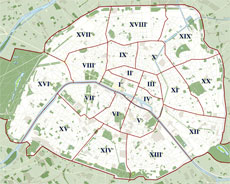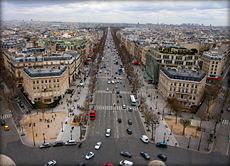Champs-Élysées

|
AVENUE
des CHAMPS ÉLYSÉES |
|
|---|---|
 |
|
| Arrondissement | VIIIe |
| Quarter | Champs Elysées. Faubourg du Roule. |
| Begins | Place de la Concorde |
| Ends | Place Charles De Gaulle |
| Length | 1910 m |
| Width | 70 m |
| Creation | 1670 |
| Denomination | 2 March 1864 |

|
|
|
The Champs-Elysées as seen from the Arc de Triomphe
|
|
The Avenue des Champs-Élysées (pronounced [ʃɑ̃zeliˈze] audio) is the most prestigious avenue in Paris. With its cinemas, cafés, and luxury specialty shops, the Avenue des Champs-Élysées is one of the most famous streets in the world, and with rents as high as $1.50 million a year for 1000 square feet (92.9 square meters) of space, it remains the most expensive strip of real estate in Europe.[1][2] The name is French for Elysian Fields, the place of the blessed in Greek mythology.
The Avenue des Champs-Élysées is known in France as La plus belle avenue du monde ("The most beautiful avenue in the world"). The arrival of global chain stores in recent years has slightly changed its character, and in a first effort to stem these changes, the Paris City government (which has called this trend "banalisation") decided in 2007 to ban the Swedish clothing chain H&M from opening a store on the avenue.[2] In 2008, however, American clothing chain Abercrombie & Fitch was given permission to open a store.[3]
Contents[hide] |
Description

The avenue runs for two kilometres (1.25 miles) through the 8th arrondissement in northwestern Paris, from the Place de la Concorde in the east, with its obelisk, to the Place Charles de Gaulle (formerly the Place de l'Étoile) in the west, location of the Arc de Triomphe. The Champs-Élysées forms part of the Axe historique. One of the principal tourist destinations in Paris, the lower part of the Champs-Élysées is bordered by greenery (Marigny Square) and by buildings such as the Théâtre Marigny and the Grand Palais (containing the Palais de la Découverte). The Elysée Palace is a little bit to the north, but not on the avenue itself. Further to the west, the avenue is lined with cinemas, cafés and restaurants (most notably Fouquet's), and luxury specialty shops.
History

The Champs-Elysées were originally fields and market gardens, until 1616, when Marie de Medici decided to extend the garden axis of the Palais des Tuileries with an avenue of trees. As late as 1716, Guillaume de L'Isle's map of Paris shows that a short stretch of roads and fields and market garden plots still separated the grand axe of the Tuileries gardens from the planted "Avenue des Thuilleries", which was punctuated by a circular basin where the Rond Point stands today; already it was planted with some avenues of trees radiating from it that led to the river through woods and fields. In 1724, the Tuileries garden axis and the avenue were connected and extended, leading beyond the Place de l'Étoile; the "Elysian Fields" were open parkland flanking it, soon filled in with bosquets of trees formally planted in straight rank and file. To the east the unloved and neglected "Vieux Louvre" (as it is called on the maps), still hemmed in by buildings, was not part of the axis. In a map of 1724, the Grande Avenue des Champs-Elisée stretches west from a newly-cleared Place du Pont Tournant soon to be renamed for Louis XV and now the Place de la Concorde.


By the late 1700s, the Champs-Elysées had become a fashionable avenue; the bosquet plantings on either side had thickened enough to be given formal rectangular glades (cabinets de verdure). The gardens of houses built along the Faubourg St-Honoré backed onto the formal bosquets. The grandest of them was the Élysée Palace. A semi-circle of housefronts now defined the north side of the Rond Point. Queen Marie Antoinette drove with her friends and took music lessons at the grand Hôtel de Crillon on the Place Louis XV. The avenue from the Rond Point to the Etoile was built up during the Empire. The Champs-Elysées itself became city property in 1828, and footpaths, fountains, and gas lighting were added. Over the years, the avenue has undergone numerous transitions, most recently in 1994, when the sidewalks were widened.
The Avenue des Champs-Elysées, because of its size and proximity to several Parisian landmarks such as the Arc de Triomphe, has been the site of several notable military parades, the most infamous of which were the march of German troops celebrating the Fall of France on 14 June 1940 and the subsequent entrance of Free French and American forces into the city after its liberation on 25 August 1944.
Premier offices and retail
In 1860, the merchants along the avenue joined together to form the Syndicat d'Initiative et de Défense des Champs-Élysées, changed to an association in 1916 to promote the avenue. In 1980, the group changed its name to the Comité des Champs-Élysées and to "Comité Champs-Elysées" in 2008. It is the oldest standing committee in Paris. The committee has always dedicated itself to seek public projects to enhance the avenue's UNIQUE atmosphere, and to lobby the authorities for extended business hours and to organize special events. Even today, the committee has approval over the addition of new business to the avenue with the Paris City administration.
Because of the high rents, few people live on the Champs-Élysées; the upper stories tend to be occupied by offices. Rents are particularly high on the north side of the avenue, because of better exposure to sunlight. The splendid architecture of the grandiose "Champs-Élysées" is admired by many people. The avenue is located right next to the Palais de l'Élysée, the presidential palace, with its rounded gate, and the Grand Palais that was erected in the late 19th century. While walking among the gardens and tree-lined promenades one could even encounter an open-air marionette theatre for children, a French tradition popular through the ages.
Finally, the avenue is one of the most famous streets for upscale shopping in the world. Adidas, Benetton, the Disney Store, Nike, Zara, Mc Donald, Cartier, Bel Air Fashion, continental Europe's largest Gap as well as Sephora occupy major spaces.[2] Traditionally home popular brands and also of luxury brands (Louis Vuitton), the Avenue des Champs Elysées confirms its world-class appeal as a prime real estate location: it has lately seen the opening of new big upscale shops such as the biggest Adidas store in the world. Abercrombie & Fitch has received permission for a flagship store there, scheduled to open 2011.[3]
Events
Every year on Bastille Day, the largest military parade in Europe passes down the Champs-Élysées, reviewed by the President of the Republic.
Every year from end of November to end of December, the 'Champs-Élysees' Committee contribute for the Holidays seasons lighting of the Champs-Élysees.The 2007 lighting of the Champs-Élysées was very successful with lighting tubes which acted like snow falling from the trees. This season is the most prestigious lighting in the world.
Since 1975, the traditional last stage of the Tour de France is the Champs-Élysées stage. The subsequent awards ceremony also takes place directly on the Avenue.
Huge and spontaneous gatherings occasionally take place on the Champs-Élysées in celebration of popular events, such as New Year's Eve, or when France won the 1998 FIFA World Cup.
See also
- List of upscale shopping districts
References
- ↑ Stretches of New York City's Fifth Avenue contain the world's most expensive real estate.
- ↑ 2.0 2.1 2.2 Elaine Sciolino, "Megastores March Up Avenue, and Paris Takes to Barricades", New York Times, 21 January 2007.
- ↑ 3.0 3.1 "Paris next stop on A&F's expansion trail" (November 25, 2008). Retrieved on December 4, 2008.
External links
- The official Champs-Elysees Avenue website (English-French-Chinese versions)
- The Champs Elysées district - current photographs and of the years 1900
- Barry Bergdoll, Columbia University: Paris maps
- Satellite image from Google Maps
|
|||||||